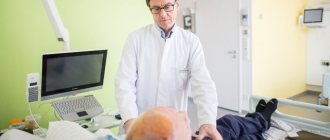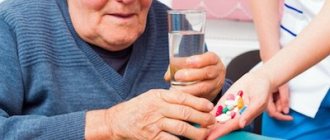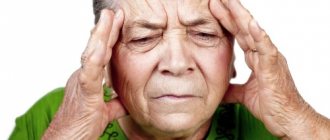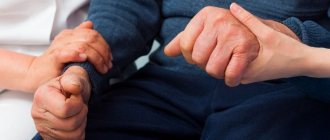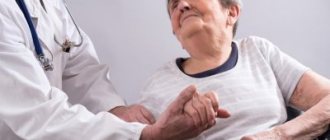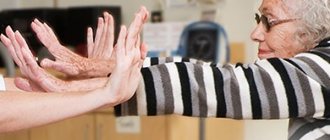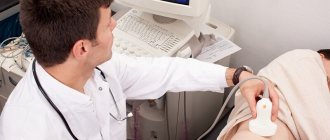Treatment of Parkinson's disease at home: exercise, hypnotherapy and other methods
Millions of people around the world today suffer from an illness, the causes of which are still not known for certain to scientists.
Parkinson's disease mainly affects those over fifty.
Psychologists note that it occurs due to severe stress.
The disease can be stopped with complex therapy - medications, special physical training, folk remedies.
Neglecting the disease can lead to a gradual destruction of the connection between the motor muscles and the brain and a complete loss of movement.
We’ll talk about treating Parkinson’s disease at home using gymnastics, hypnosis and massage in this article.
How to treat: rules of outpatient therapy
The main symptoms of the disease are severe trembling of the limbs and head, muscle stiffness and loss of coordination, and insomnia.
Every day they worsen, the patient finds it more and more difficult to walk, eat, and other everyday activities.
Therefore, it is important to see a doctor and get an individualized treatment plan.
It is possible to treat Parkinson's disease at home if the patient is able to take care of himself (in the initial stages) or is helped by relatives.
The modern approach to therapy provides for the possibility of outpatient treatment, subject to compliance with all doctor’s recommendations.
It is necessary to consume foods with high levels of fiber - fruits, vegetables, grains, black bread, boiled legumes, oatmeal.
This menu prevents constipation, which patients are prone to. It is recommended to eat more boiled or baked foods with a minimum content of animal fats, and drink more fluids.
Organizing a proper diet at home is not so difficult. It is enough to take a sample menu from the doctor. The process of eating food itself is much more complicated.
Tremor prevents the patient from eating a full meal. Spoons with a thick handle (can be wrapped in cloth), attaching a plate to the table, or drinking from a straw will help in such situations.
The treatment plan for Parkinson's disease at home includes massage, exercise therapy, hypnosis, the ranc method, the use of folk remedies, etc.
In combination with proper nutrition and a psychologically favorable environment, complex therapy gives good results.
Is it possible to do therapeutic massage: indications and contraindications
Gradually the patient loses the ability to fully care for himself.
Reducing muscle rigidity and expanding the motor mode is possible with regular massage of the lower and upper extremities already at an early stage of the disease.
Manual manipulation can be carried out by inviting a specialist to your home. Massage techniques are relatively easy, so often the patient’s relatives often do it themselves.
The total time of one session should be at least an hour. The procedure begins with stroking, followed by rubbing. It helps relieve muscle stiffness, increase blood flow and reduce nervous excitability.
Next, the specialist kneads the skin and muscle groups, reducing the negative effect of the disease. This lasts for 15-20 minutes. Then the limbs are flexed and extended in all joints for 20-25 minutes.
The most popular massage method for Parkinson's disease is displacement and squeezing. The movements are performed quickly and energetically, which improves blood circulation and has a positive effect on the superficial muscle layers, subcutaneous tissue and connective tissue. The massage therapist performs them for 15-20 minutes.
For parkinsonism, the technique of tapping and striking is good. It causes contractions along the length of muscle fibers, thereby increasing overall tone. And clapping with palms in combination with chopping and striking techniques further improves the patient’s general condition.
If necessary, sessions are carried out in courses of 15-20 procedures, repeated once every two months.
How to do therapeutic massage:
Exercise, exercise therapy
To delay the onset of disability and improve coordination of movements, a patient with Parkinson's disease needs to engage in active therapeutic exercises. In the early stages it gives especially noticeable results.
At the onset of the disease, many patients engage in aerobics, skiing, outdoor ball games, and dancing. Over time, the loads should be reduced. You can exercise on exercise machines and go to the pool.
Typically, a set of exercises for Parkinson's disease begins with breathing exercises.
They do it near the wall, squatting and turning while inhaling and exhaling.
The “candle” exercise is very popular.
To improve your posture, you can press your back against the wall or bend and unbend your torso while sitting on a chair. After this, you can do 1-2 abdominal exercises from a lying position on your back.
Further manipulations are recommended to strengthen the spine. They are done standing, tilting and turning the head from side to side, retracting and retracting the shoulder blades. Lifting your legs from a supine position helps strengthen your lower body.
You can complete the complex with exercises for fine motor skills (rotation of hands in the wrist joints, touching fingers) and for the development of facial expressions (moving the tongue from one corner of the mouth to another, depicting emotions, etc.). Before performing the exercises, the patient should consult a doctor to adjust loads. It is necessary to organize classes so that they include all types of loads - stretching, aerobic and strength training.
Physical education should take place daily, repeating each exercise 8-10 times until a slight feeling of fatigue appears. Under no circumstances should you be overtired.
A set of physical exercises, exercise therapy gymnastics (physical therapy) for Parkinson’s disease on video:
Hypnosis
Some Parkinson's patients sometimes resort to potentially effective but unproven methods to combat it. One of these is hypnosis.
A scientific article was published in the International Journal of Clinical and Experimental Hypnosis, according to which a certain 51-year-old patient (his personal details were not disclosed) underwent three sessions of hypnotherapy, and then learned self-hypnosis.
As a result of this treatment, he noted a decrease in tremors and anxiety, improved sleep quality and normalization of blood pressure.
There is no data on how exactly the sessions took place in open sources.
However, in theory, home treatment for illness may include such a referral, subject to referral to a professional hypnologist.
RANC method
This is one of the innovative methods of therapy for parkinsonism, invented by Russian scientists. It is based on the restoration of active nerve centers in difficult cases when drug therapy is powerless.
Specialists stimulate the reticular formation through the accessory nerves by injecting a painful drug (for example, 5% Analgin) into all affected areas of the trapezius muscles.
At the end of the procedure, a short pain occurs in the body, catalyzing the process of establishing the functioning of various regulatory systems.
Doctors claim that obtaining a therapeutic effect from the RANC method is possible within 1.5 months after the start of the procedure . For example, it is practiced by neurologists A.A. Ponomarenko from Krasnodar, A.M. Mamedyarov from Moscow and others.
While undergoing home treatment, the patient can make an appointment with a doctor and consult with him about this treatment method.
Usually it is resorted to in the last stages of the disease.
In recent years, Parkinson's disease has ceased to be a death sentence for people.
The best confirmation of this is the opportunity to be treated at home and independently choose a technique, the emergence of innovative methods of therapy and their availability to patients.
Studying methods of combating the disease allows us to conclude that the most important component in it is support from loved ones. A comfortable emotional state is the key to a long, high-quality life.
Source: https://nerv.guru/zabolevaniya/parkinson/lechenie-bp/domashnyaya-terapiya.html
Correction of psychological state
Along with motor rehabilitation, patients with Parkinson's disease need psychotherapeutic support. Often the disease affects a person’s appearance: facial expression changes, facial expressions become noticeably poorer, and the voice becomes quiet. As the disease progresses, articulation suffers. A person suffering from Parkinson's disease is usually embarrassed by his condition and finds it difficult to feel relaxed in communication. Due to limited movement, it is difficult for patients to do their usual activities. Working with a psychotherapist helps to overcome an emotionally depressed state and teach the patient to adequately perceive his condition. It is very important for patients to continue communication with loved ones and take part in family life. Psychotherapeutic correction also includes sessions with family members and the patient’s environment.
Complex of physical therapy for Parkinson's disease
› Exercise therapy for diseases
Parkinson's disease is a severe brain pathology associated with a disorder in the metabolism of dopamine, which regulates the conduction of nerve impulses.
With its deficiency, motor activity suffers: muscle tone increases, they begin to contract slowly and with difficulty, and the person is not able to move at the usual pace.
In such situations, drug therapy for Parkinson's disease is supplemented with physical therapy for all muscle groups.
Features of the treatment of Parkinson's disease with physical exercises
Against the background of constant muscle tension, a patient with parkinsonian disorders changes his posture, his gait becomes shuffling, his movements are slow, tremors in the limbs and balance problems appear. In the final stages of the disease, the patient becomes completely immobilized due to impaired functional activity of the muscles.
Treatment of patients with parkinsonism includes drugs based on levodopa, which replenish dopamine deficiency, as well as elements of physical and breathing exercises, exercise therapy in combination with medications act as follows:
- Reduces tone in tense muscles (this also reduces trembling);
- Restore mobility in the cervical, thoracic and lumbar spine;
- Regulate coordination of movements;
- Normalize motor skills and gait;
- Increased thoracic kyphosis is leveled;
- Increase range of movements;
- Improves mood and general condition.
A set of exercises useful for Parkinson's disease
Each lesson should last at least 10 minutes and include the following elements:
- Power loads;
- Stretching tasks;
- Dynamic joint training;
- Mimic gymnastics;
- Breathing techniques.
Note!
The number of classes per day is determined individually by the physical therapy doctor and depends on the severity of the patient’s condition and the form of the disease.
It is recommended to do an average of 10-12 approaches.
Exercises to improve posture
- In a sitting position, we try to straighten our back as much as possible, resting our palms on the lumbosacral region.
- Still sitting, place your feet shoulder-width apart and place your palms on your waist.
We lean back and forth. You can complete the task while holding the back of a chair. - From a similar position, we tilt the body left and right.
- Lean against the wall so that only the occipital protuberance, shoulder blades, sacrum and heel bone are in contact with it.
Press firmly with the interscapular area on the vertical surface.
Abdominal exercises
- Stretch out on the floor with your arms outstretched at right angles to your torso, palms up. Twist your body to the right, covering your left palm with your right, and vice versa.
- Lie on your back, pull your feet towards your buttocks.
Raise your upper torso towards your hips. You can help yourself with your hands, hugging your knees with them and pulling your body forward. - Lie flat, arms at your sides, feet facing you. Raise your head and shoulders, trying to see your toes.
- If possible, pump your abs in the classic way, with your hands behind the back of your head.
In this case, an assistant can fix your legs in the area of the knees and shins.
Exercises for the neck and shoulder muscles
- We consistently bow our heads to one shoulder girdle and to the opposite one.
- We tilt the head to the chest and throw it back to improve mobility in the cervical vertebrae.
- We slowly turn our heads in one direction or the other, trying to examine the surface of the shoulder blades. In this case, there is no need to rush, so as not to provoke dizziness.
- We smoothly make circular movements with our heads, first pressing the chin to the chest, then the ear to the shoulder, the back of the head to the spine, the second ear to the shoulder girdle and back.
Exercises for the muscles of the shoulder girdle
- As you exhale, raise your shoulders up, and as you inhale, lower them. Significant tension in the muscles of the upper shoulder girdle should be felt.
- We place the fingertips on the shoulder joints and carry out rotational movements in them alternately anteriorly and posteriorly.
- We place our arms perpendicular to the body, bend them at the elbows, bringing our hands to the front surface of the shoulder joints. As you inhale, we try to connect the shoulder blades as much as possible; as you exhale, you should relax and take the starting position.
- Take a gymnastic stick in your hands, extend it in front of you parallel to the floor and pretend that you are working with an oar while rowing with one or the other hand.
Hand exercises
- We approach the wall at the length of an outstretched arm, rest our palms on it and smoothly lean forward, shifting our body weight onto our hands. We do not stick out our buttocks. Then we push off the wall with our hands and straighten up.
- We sit down at the table, placing our forearms on the tabletop with our palms down.
We rhythmically turn the hands, either palmally or with the back surface up, moving faster and faster. - We clench our fingers into fists and rotate our wrists, first inward, then outward.
- We take turns connecting the pads of our thumbs with all the others, gradually increasing the pace.
Exercises for the muscles of the lower limbs
- Lie down on the floor. Bend your left knee without lifting your sole off the floor. Place your right hand on your knee joint and pull it to the right for 10 seconds. Repeat with the other leg.
- Turn over face down, resting on your forearms.
Bend your legs alternately at the knee joints, trying to touch your heel to the buttock area. - We sit on the floor, stretch our legs forward. Rotate your feet first inward, then outward.
- We squeeze and straighten our toes.
Exercises to improve knee movement
- Sitting on a stool or on the edge of the bed, we straighten and bend our legs at the knee joints in turn.
- In the starting position from the previous exercise, stretch out the right leg and place it on a low stool.
Sliding our hands along the front surface of the leg, we stretch as far as possible, touching the foot if possible. We freeze in this position for 10 seconds and straighten up. Repeat with the left leg. - Sit on the floor, stretching your legs and resting your straightened arms on the floor slightly behind your back. Bend your legs at the knee joints, pulling your feet towards your pelvis, and return to their original position.
- Lie down on a horizontal surface and do the classic version of the “bicycle” exercise, simulating pressing the pedals.
Tension and relaxation of the thigh and calf muscles
- Leaning on the back of a chair on one side, we lunge forward alternately with one and then the other leg. We try to get down as close to the floor as possible and hold in this position for 15-20 seconds.
- Still holding onto the chair, we first stand on our tiptoes, stretching the calf muscles, and then again on the full sole, relaxing.
- We perform regular or half squats at a support.
- We lie on our backs straight and alternately raise our straightened legs up as far as possible.
Exercises for facial muscles
In Parkinson's disease, not only skeletal muscles suffer: facial muscles also become less mobile, “waxy”. With the help of a special complex of physical therapy, the patient is able to get rid of the mask-like, amicable face and again actively express emotions. To better control the correct execution, you should practice in front of a mirror.
- Alternately portray surprise, joy, and anger on your face. Hold each expression for 3-5 seconds.
- Consistently raise your brow ridges, frown, and close your eyes tightly.
- Stretch and purse your lips tightly, then open them slightly and say “cheese.”
- First, at a slow and then at the fastest pace, stretch your lips, and then pull them out with a tube.
- Inflate and deflate your cheeks.
- Stick out your tongue and move it alternately left and right, up and down.
- “Draw” circles with the tip of your tongue, first clockwise and then counterclockwise.
Perform each exercise at least 10 times.
Important information!
Tongue exercises are necessary to prevent swallowing disorders. These disorders occur in the later stages of the disease and cause serious complications in the respiratory tract when food gets into them.
Breathing exercises
The function of the respiratory muscles in Parkinson's disease also suffers: the depth and efficiency of inspiration decreases. This is also facilitated by changes in posture and the formation of stoop. To restore the normal biomechanism of inhalation and exhalation, the following exercises are recommended:
- Sit on a stool or the edge of the bed and place your palms on the front abdominal wall. Inhale deeply, feeling your stomach inflate. Exhale slowly through pursed lips.
- Go to the wall and press your back against it so that your spine touches it along its entire length: from the lower cervical region to the sacrum. As you inhale, extend your arms upward, also along the wall. As you exhale, cross them over your chest.
- As you inhale, stand on your tiptoes, raise your arms up and stretch, while exhaling, stand on your full foot, bend down so that your arms hang freely.
Each time you need to do 10 breathing movements.
Additional tips and tricks
When performing any exercise, you need to follow the rules to achieve the greatest effectiveness from your workout:
- You should exercise regularly, in accordance with the regimen prescribed by the doctor.
- It is advisable to start training after taking medications, when the symptoms of the disease are less pronounced, it becomes easier to move, and the patient’s physical activity increases.
- Before training, it is advisable to perform a light muscle massage to improve local blood flow and reduce spasm.
- You need to move slowly at first, then gradually increase the pace.
- Rhythm is very important, so it is better to practice with appropriate music or a loud score.
- You should not bring yourself to excessive fatigue. Normally, half an hour after finishing classes, your strength should be fully restored and your energy should appear.
- After completing the main gymnastic complex, time is allocated for breathing training.
Recommendations from experts!
In the early stages of Parkinson's disease, neurologists recommend not only classical exercise therapy, but also activities such as walking, skiing, swimming, cycling, playing volleyball, badminton, and golf.
Patients should overcome a shuffling gait through regular long walks; through swimming, they should restore their usual posture; dynamic games help improve balance and posture.
Exercise therapy for Parkinson's disease is necessary primarily to maintain normal motor activity and the ability to move. With adequate drug therapy, physical activity slows down the progression of the process and makes the course of the disease easier, preventing the development of complications.
— Physical therapy exercises for Parkinson’s disease
Complex of physical therapy for Parkinson's disease Link to main publication
Source: https://LfkPlus.ru/lfk-pri-boleznyax/bolezni-parkinsona.html
The effects of exercise on the brain
Exercise not only helps the physical aspects of PD, but also the mental ones. They have been shown to help relieve symptoms of fatigue, mood, sleep problems and mental health.
Dopamine is a neurotransmitter that controls the reward center of the brain and also regulates movement and emotional responses. In PD, there is a deficiency of dopamine.
While exercise has not been shown to increase the amount of dopamine in the brain, research suggests it helps it be used more efficiently.
Recommendations for performing gymnastics
When performing exercises, you must adhere to the following recommendations:
- Exercise must be done daily.
- The number of daily exercises should be discussed with a specialist, who can be either a neurologist or a physical therapy methodologist.
- After each exercise performed, the patient should definitely feel slightly tired. At the same time, it is not allowed to overstrain the body with exhausting and grueling activities. After a correctly performed exercise, the patient should feel comfortable in the muscles and pleasant fatigue.
- It is necessary to select such sets of exercises that will involve all the muscles of the body. A special exercise is selected for each muscle group.
- The exercise therapy complex should include exercises that help practice those movements that were most difficult for the patient.
- Before you start exercising, it is recommended to do a short warm-up to prepare and warm up your muscles.
- Each exercise should be completed smoothly and slowly.
- Having mastered this or that exercise, you need to gradually increase the load on it : perform the exercise more times, or choose heavier dumbbells.
- When eating food, it is recommended to chew it as thoroughly as possible , thus affecting the jaw muscles.
- If the patient loved to sing before illness , then to develop the muscles of the jaws and throat, you can include singing in a set of daily exercises.
- Under no circumstances should you exercise on slippery floors or in poorly lit rooms. When choosing a place for training, preference should be given to those rooms where there are carpets that do not allow the patient to slip.
- If the patient does not feel well enough to perform exercises such as squatting or walking, then the first time exercise therapy is recommended to be performed in bed or on a special training mat.
Experienced specialists recommend that each patient choose his own hobby, for example, swimming, dancing, yoga, etc. It is important that the patient really likes the chosen activity and does it with great pleasure. As practice shows, such patients achieve significantly better results compared to others.
Contraindications
Installation of an electrical stimulator is a last resort in the treatment of Parkinson's disease. It is not used if the patient has any serious concomitant somatic pathologies. The approach is prohibited if the patient has suicidal thoughts or signs of deep depression. The device is not used if the victim is over 75 years old or has a pacemaker installed. Before carrying out the procedure, it is necessary to use all possible drug therapy options and make sure that the desired effect is absent.
The device is not installed if the victim is over 75 years old.
The basis of the gymnastics plan
The gymnastic plan for this disease consists of:
- exercises .
- Performing soft movements - exercises for joints.
- Exercises with dumbbells with a gradual increase in loads and replacing dumbbells with heavier ones.
- Breathing exercises.
- Walks in the fresh air.
- Massage.
The choice of one or another set of exercises depends on the stage and form of the disease, as well as on the individual characteristics of the patient’s health condition.
Initial stage of the disease
In the initial stages, patients are recommended:
- Walk on treadmill .
- Perform movements, increasing their amplitude.
- Perform swing movements, throw the ball with each hand in turn, kick the ball with your feet.
- Practice walking along a line and then along a narrow path equipped with obstacles.
- Simulate skiing and rowing.
- Take daily walks in the fresh air.
- Play some sports - badminton, golf, golf.
Expanded stage
The advanced stage is characterized by postural disturbances, the elimination of which requires the following:
- Do breathing exercises.
- Master special techniques that allow you to turn over in bed, sit down, stand up, and walk.
- Perform simple stretching exercises.
- Learn techniques to suppress tremor.
- Perform exercises to help restore normal posture.
- Practice holding the pose.
On this topic
The advanced stage is accompanied by the patient’s loss of motor activity, “freezing” of joints and muscles. To reduce such unpleasant manifestations, it is useful for patients to practice walking under command signals, for example, “left-right”, or counting “one”, “two”, “three”.
Also, the set of exercises for patients with an advanced stage includes walking to marching music and walking with support or with the help of a little support from strangers.
Occupational therapy
Occupational therapy helps patients maintain independence in everyday life, at home, adapt to the disease, and become less dependent on its symptoms. The specialist diagnoses disorders in terms of the ability to self-care (dressing, washing, eating and preparing food) and performing professional duties and draws up an individual training program to restore those skills that the patient primarily needs. Classes are held in a training apartment; there is also a simulator for restoring driving skills.
The center's specialists also give recommendations on home improvement and the use of special tools that will help patients remain independent and feel safe.
Is it possible to treat the disease using devices?
Parkinson's disease is characterized by degeneration of brain tissue, leading to a decrease in the functionality of entire parts of the organ. Even with constant medication use, adverse processes do not stop, but only slow down. With a combined approach to the treatment of pathology, maximum inhibition of negative reactions can be achieved. For this purpose, patients are additionally recommended: diet, massage, physical therapy, attending sessions using hardware techniques.
The physiotherapeutic treatment option is selected by the doctor in accordance with the stage, form, and clinical picture of Parkinson’s. Independent actions threaten to aggravate the situation, develop complications, and reduce the effectiveness of basic therapy.
It is important to understand that hardware techniques cannot cure the disease. They cannot be used instead of taking medications - they are only an addition that enhances the effect of specialized medications.
The effectiveness of exercise therapy
The main task of exercise therapy is to solve motor problems. Special gymnastics helps:
- Stretch muscles that are constrained by stiffness syndrome.
- Develop joints and increase their mobility.
- Improve the quality of movements.
When regularly performing gymnastic exercises, patients lose the constant feeling of stiffness, their posture straightens and coordination of movements improves. Also, exercises allow you to restore your gait to a natural level.
To achieve tangible results, patients must do exercises according to the recommendations of the attending physician, observing a certain frequency. It is important to remember that with too much physical activity, no less unpleasant symptoms can occur than with its lack.
Patients with Parkinsonism are characterized by chronic depression, and constant exercise helps to change their psychological state: satisfaction with the quality of their life and health increases.

